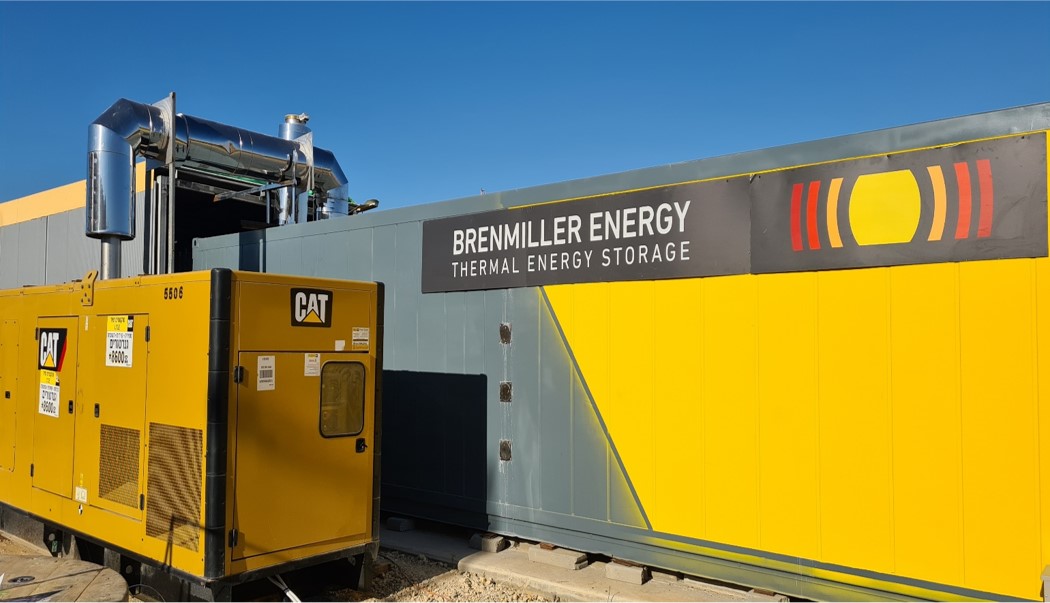Credit: Jeff St. John- Canary Media
Brenmiller Energy’s boxes of hot rocks are being deployed to turn electricity into steam heat, boost campus heat-and-power systems, and make power plants more efficient.
Doron Brenmiller, co-founder of Brenmiller Energy, knows all about the useful things hot rocks can do.
Over the past 12 years, the Israel-based manufacturer of thermal energy storage systems has evolved from producing heat batteries for a specific purpose — solar-thermal power plants — to heat batteries for a much wider range of applications.
Brenmiller Energy’s bGen systems, which use crushed rock as an energy-storage medium, are now being deployed to turn cheap electricity into heat for hospitals and food and beverage processing plants. They’re boosting the efficiency of cogeneration plants that produce electricity and heat at college campus buildings. And they’re being installed to store excess heat from the steam driving fossil-gas-fired power plants to help them more efficiently balance the ups and downs of increasingly renewable-powered grids.
This roster of projects represents a cross section of use cases not only for Brenmiller Energy but also for the dozens of other thermal energy storage companies that have won hundreds of millions of dollars of investment over the past decade or so. There’s good reason for this investor enthusiasm, said Brenmiller, whose company has raised $100 million and as of May had 49 potential contracts for deployments valued at more than $500 million.
The technologies involved in thermal energy storage — systems that use a medium to absorb, retain, and dispatch heat — are now well understood, he said. And the ability to shift when and how heat is generated and consumed is critical to decarbonizing industrial processes that rely on vast amounts of steam and hot water.
But thermal energy storage has potential beyond providing clean heat: It’s expected to be more cost-effective than conventional lithium-ion batteries for storing cheap clean electricity over longer durations, which will be needed as solar and wind become the primary source of power. “The name of the game is to make the fuel for your application — the electricity — cheap enough,” Brenmiller said.
But “it’s not enough to have a good storage medium, a good technology, a good concept,” he added. “You need to be counted on to deliver the right performance at the right cost.”
A heat battery designed for different jobs
The firm’s bGen systems make use of rock that can be sourced “almost anywhere,” Brenmiller said. The company places this crushed rock into thermally insulated containers, or bCubes, that can absorb heat and store it for days or even weeks. The company currently manufactures its systems at an automated factory in Israel and plans to build “a few more around the world over the next few years,” he said.
Within those bCubes are five pipes that make up what Brenmiller called an “integrated thermal exchanger.” Some of those pipes serve as an input to “charge” the crushed rock with heat from hot air, steam, or electrical resistance heaters. Others serve as an output through which heat is extracted via superheated air, steam, or thermal oils.
This design allows bGen systems to use different inputs and outputs depending on what customers need, he said. It also allows bGen systems to simultaneously absorb and discharge incoming heat.
The overall efficiency of the system is quite high: Of the heat going in, approximately 97 percent can be extracted. But in Brenmiller’s view, “how to optimize it to work in the market is more critical” — and that requires some careful design and engineering to meet particular customers’ needs.
Turning cheap (and clean) electricity into heat
Take the power-to-heat applications Brenmiller deploys in Israel. These projects include a bGen system at a beverage processing plant owned by Tempo, one of Israel’s biggest beverage producers for brands including Heineken and Pepsi. Brenmiller Energy’s system will be used to generate the steam for processes such as sterilizing bottles “using off-peak electricity and solar PV” to replace the diesel-fired boilers the plant now uses. A similar project at Wolfson Medical Center in Tel Aviv will replace heavy fuel oil boilers.
In both cases, these facilities are eager to replace costly fossil fuels with cheaper grid electricity, he said. But they’re not willing to make that switch unless the steam and hot water will be available at the same temperatures and pressures they’re getting from their existing boilers.
Brenmiller designs its systems to ensure their heat output can be held stable, no matter how much energy is available and going into storage on the other end. Without that guarantee, industrial sites simply aren’t willing to make the switch, he said.
About two-thirds of Brenmiller’s project pipeline involves customers that plan to purchase and operate bGen systems on their own. But, like many other thermal storage providers, Brenmiller is offering customers an option to avoid the upfront cost of buying bGen systems and simply contract for the heat they’ll be getting from them instead.
That’s the case for Brenmiller’s newly announced 12-year “Heat as a Service” agreement at a pet-food processing plant in Hungary owned by Partners in Pet Food. Romain Barral, the company’s head of engineering and lean manufacturing, told Canary Media in an email that its plant will use 25 to 30 percent less fossil gas once the bGen system is installed. The company considered rooftop solar at the facility, but “Brenmiller technology was considered a superior option for our goals.”
Brenmiller noted that “taking electricity and converting it to heat would have been seen as something not viable, physically or economically,” only a few years ago. But with larger amounts of wind and solar power coming onto the grid, “an electron doesn’t always have the same value. Sometimes that value can be negative — there’s too much of it.”
The European Union’s Emissions Trading System and national mandates that pass the cost of carbon emissions on to big industrial companies, combined with the high price of fossil gas, have made power-to-heat systems paired with thermal storage “quite promising in Europe today,” he said.
Similar dynamics are driving investment for other thermal energy storage providers like California-based Rondo Energy, which in June secured a commitment of 75 million euros ($80.6 million) from public and private sources to install its heat batteries at industrial sites across Europe.
From waste heat to time-shifted “recovered” heat
The economics are tougher in the U.S., where no financial penalties are assessed for carbon emissions and the price of fossil gas is much cheaper than in Europe. Today, thermal energy storage projects in the U.S. from companies including Rondo Energy and Boston-based startup Electrified Thermal Solutions are backed by federal grants aimed at curbing industrial emissions, which remains one of the tougher sectors to decarbonize.
“In the U.S., I believe the same mechanisms will evolve over time” to support power-to-heat applications for thermal energy storage, Brenmiller said. But in the meantime, his company is starting to deploy bGen systems in the U.S. for another use case: heat-to-heat applications.
The first such application is at the State University of New York (SUNY) at Purchase campus, where Brenmiller worked with the New York Power Authority (NYPA) to install a bGen system alongside a combined heat and power (CHP) system at the university’s gym.
CHP systems, also known as cogeneration systems, are fairly common at university and corporate campuses, hospitals, and other sites that need both electricity and heat. By burning fossil fuels to generate power and capturing the excess heat that would otherwise be wasted, CHP systems can do both tasks at a lower cost than doing them separately.
But the demand for heat and for power from CHP systems doesn’t always match up exactly, said Steve Wilkie, director of research and development at NYPA. That’s the case at SUNY Purchase’s gym, which needs heat during the day when the building is occupied but doesn’t need it overnight.
“If we can’t use the heat because we have no use for the heat, we truly waste the heat,” he said. With the bGen system, “I’m storing heat in the middle of the night, when I don’t necessarily need to use it, and I’m shifting it to the middle of the day, when I do need it.”
The heat stored in the bGen system can also augment heat from the CHP system on particularly cold days, when “the demands for heat become greater than what we can recover from the exhaust itself,” he said.
Not all thermal energy storage systems are built to take in waste heat, Brenmiller noted. Some are designed to heat their storage media directly via electricity. Others rely on external electric heaters that blow superheated air through storage media, which tends to lead to greater energy loss than bGen’s integrated system, he said.
Determining whether the benefits thermal storage delivers to SUNY Purchase make up for the installation cost remains a work in progress, Wilkie said. Changing prices for fuel and grid electricity factor into that equation, as do the efficiency gains realized from being able to run the CHP system at a more stable and constant rate. What’s more, “new developments are always more expensive than they’d cost you two or three years down the road,” he said.
“Heat to power” — making power plants more efficient
Another intriguing use case for thermal storage systems is on the power generation front — specifically, storing excess heat to boost electricity generation later.
Italian energy developer Enel Green Power is testing this use case with Brenmiller’s technology at a fossil-gas-fired power plant in Tuscany owned by its parent company, Enel. That project will pipe steam for the power plant’s turbines through a complex of bGen systems that can store up to about 24 megawatt-hours of heat at a temperature of about 550 degrees Celsius for at least five hours, and then discharge that stored heat to make steam to generate electricity later.
That stored-up energy can allow the plant to reduce how often it must ramp up or ramp down its own steam-generating capacity, which erodes the efficiency of the plant’s operations. It can also allow the plant to start up faster and alter its generation output more quickly than would otherwise be economically viable, which is useful to react to the ups and downs of renewable power generation.
“Flexibility and adequacy are two essential components of an efficient and reliable electricity system and they can be provided in an increasingly efficient way by storage systems,” Salvatore Bernabei, CEO of Enel Green Power, said in a 2022 statement marking the start of the project.
The same imperatives have led turbine manufacturers to improve the flexibility of their systems, as well as to integrate lithium-ion batteries with gas turbines in so-called hybrid power plants. These systems can significantly reduce fuel consumption, and thus carbon and air pollutant emissions, for the fast-ramping services that power plants are asked to provide at times when the balance of supply and demand on power grids is changing rapidly.
To be clear, conventional grid batteries are increasingly cost effective alternatives to gas-fired power plants on their own — and from a climate perspective, the direction the grid needs to move toward, along with adding more solar and wind. But in the near term, some amount of gas generation is here to stay, and making it more efficient by tacking on storage can have a meaningful impact on emissions.
And for larger gas plants, thermal energy storage may be a better option than lithium-ion batteries, Brenmiller said. Thermal storage systems take up less space per unit of energy stored than lithium-ion batteries do, he said. They can also deliver their stored energy without the efficiency losses that occur in converting electricity from the alternating current generated by power plants to the direct current that goes into batteries, and then back again to alternating current to flow to the grid.
NYPA has also explored adding a bGen system to one of its gas-fired power plants. That project, funded by the U.S. Department of Energy, didn’t receive follow-on funding, which led to its cancellation. But the early-stage research indicated that the concept was sound, Wilkie said.
That’s because the plant in question often has to shut down when demand for electricity on the grid wanes, he said. “There’s a cost associated with shutting it down — you’re adding wear and tear you wouldn’t have if you continue to operate consistently at a steady power rate,” he noted. “The thought was that that plant could continue to operate in those periods of time to generate and store heat that could be deployed” when electricity demand was higher.
Whether or not that would be cost-effective at commercial scale remains an open question, Wilkie said. “We felt encouraged by what we saw, but some of that information we just could not complete.”
Other ways to generate electricity from thermal batteries exist. Startup Antora Energy, which is targeting many of the same industrial heat and renewable energy storage targets as Brenmiller, Rondo, and other companies in the space, is also working on using specialized thermophotovoltaic (TPV) panels to convert thermal energy to electricity. Startup Fourth Power has set its sights explicitly on heat-to-electricity TPV, and boasts heat batteries made from advanced materials and using liquid metal to move heat.
These are more technologically complex approaches to turning heat to power, however, and may take longer to prove themselves at scale. Using thermal storage to reduce the emissions of gas power plants serving grids with rising amounts of wind and solar power could be a shorter-term solution.
The Enel project is still in its test stages, Brenmiller noted, which means it’s too early to calculate the benefits. But the experiment is in keeping with a much broader push by the energy industry to find ways to allow their power plants to “become more and more flexible to become more competitive with renewables.”
Jeff St. John is director of news and special projects at Canary Media. He covers innovative grid technologies, rooftop solar and batteries, clean hydrogen, EV charging, and more.





 Trendingsmallcaps.com, a leading financial news informational web portal designed to provide the latest trends in Market News, Investing News, in-depth broadcasts on Stock News, Market Analysis and Company Interviews.
Trendingsmallcaps.com, a leading financial news informational web portal designed to provide the latest trends in Market News, Investing News, in-depth broadcasts on Stock News, Market Analysis and Company Interviews.